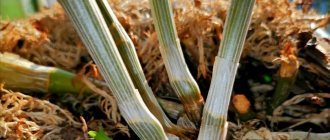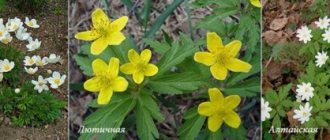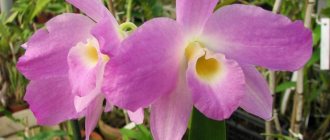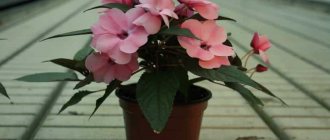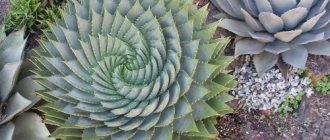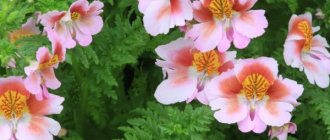The herbaceous perennial plant Dendrobium orchid is a member of the Orchidaceae family. From Greek “dendrobium” is translated as “living on a tree”, this is due to the fact that this plant is an epiphyte, but among the species of this genus there are also lithophytes that live on stones. This genus includes more than 1,200 species that can be found in natural conditions in the Philippines, Australia, New Zealand, Japan, China, Oceania and New Guinea. All these species can differ greatly from each other in both the shape and color of foliage and flowers, the manner in which the flowers are arranged on the stem, the time of flowering, and much more.
Detailed description and photo
Dendrobium nobile (Dendrobium nobile) or Dendrobium noble is a natural species of the genus Dendrobium from the Orchidaceae family.
From the history
Habitat: high mountain forests of Southeast and South Asia. The first Dendrobium was described by the Swedish botanist Olaf Schwartz. And in 1836, Europe learned about a new species that was found in India. For its pleasant aroma and spectacular flowering, it was given the specific epithet “nobile” - from the Latin noble .
Currently, the natural species is on the list of protected plants (Appendix II of the CITES Convention). For 120 years, many hybrids have been created on its basis, which are grown as a potted crop. Therefore, in the pedigrees of all store-bought Nobile orchids there is only a minimal percentage of the natural species. And the higher it is, the more expensive the plant.
What does Dendrobium nobile look like?
Nobile has the appearance of a tall bush with one or several stems . In the wild, the height reaches a meter, and at home it is about 60 cm.
The stem is elongated pseudobulbs that are divided into segments. Erect, fleshy, glossy, deviating downward over time. At the attachment points of the leaves there are buds that develop into peduncles or sprouts (babies). Every 2-4 years the stems lose leaves, turn yellow and die.
Flowers of different hybrids can be collected in inflorescences of up to 4 pieces each . Flower diameter is from 5 to 10 cm. Petals have a waxy texture. Most often two-colored: white at the base and with lilac, violet, red or orange ends. There are also plain ones: white, pale pink, yellow. The lip is ovoid, with a round purple or yellow spot.
The leaves are linear-lanceolate, light green, located along the length of the stem.
How is it different from other orchids?
Dendrobium nobile forms flower stalks not only at the top of the pseudobulb, but along its entire length.
The number of flowers reaches 70 pieces. Cut flowers remain fresh for about 10 days.
D. Himezakura
A hybrid, its parents were Dendrobium Oberon and Dendrobium Cassiope.
It was developed in 1991 and officially recognized in 1995. At the moment it has become the most popular hybrid bred on the basis of Dendrobium nobile.
Pseudobulbs are long, reaching up to 45 cm in length, with a width of no more than 2 cm, thin, divided into segments.
Its difference and peculiarity is that the more sunlight, the shorter the pseudobulbs.
Peduncles grow from internodes, on which 3-5 flowers usually appear, about 5-6 cm in diameter.
Differs in color options:
1. Dendrobium Himezakura Sanokku – White flowers with light pink hues at the tips and a bright, crimson color inside.
2. Dendrobium Himezakura Fujikko – Light pink flowers with a green and white lip.
3. Dendrobium Himezakura Sanock – White flowers with a bright, crimson color inside.
Varieties
The most famous line of hybrids based on Nobile is named after the Japanese breeder - Yamamoto hybrids.
Let's look at the most popular Greeks.
Yellow Song (D. nobile Yelow Song Canary)
The height of the bush is 40 cm, the flowers are single-colored, bright yellow, 6 cm in diameter. The lip is rounded, funnel-shaped, with wavy edges and an orange spot. The aroma is fruity and floral .
Fancy Angel (D. nobile Fancy Angel Lycee)
With a delicate lemon aroma. The stems are 30 cm high. The flowers are velvety, about 6 cm in size. The color of the petals is white and lilac. The lip is white, with a lilac edging and a yellow spot in the center.
Spring Dream (D. nobile Spring Dream Apollon)
Plant height 45 cm. The flowers are white, diameter 5-6 cm, with a large yellow spot on the lip. Petals with wavy edges. The aroma is fresh, fruity and herbaceous .
Medicinal properties
In China, tea was prepared based on Dendrobium, which helps reduce fever. In alternative medicine, it was believed that the orchid had beneficial properties and extended human life. In some cases, the flower was used as a treatment for pulmonary tuberculosis and anorexia. Is the plant poisonous or not?
Scientists have conducted studies that have shown that the large amount of alkaloids in Dendrobium is a strong poison, but only if the plant juice is used in large doses.
Landing
The roots of this orchid do not participate in photosynthesis, but they need good aeration.
Pot - with a drainage hole at the bottom and aeration walls around the circumference (plastic, ceramics, clay). If a flowerpot, then 1 cm wider than the diameter of the pot.
The soil is a mixture of coarse and fine pine bark, sphagnum moss, peat and coal. A ready-made substrate for orchids is suitable.
How to plant correctly:
- A layer of sea stones is placed on the bottom of the pot, and several large pieces of bark are placed on top.
- Install the plant, straighten the roots and add soil 1-2 cm below the edges of the pot.
- The first watering is 3-5 days after planting.
Priming
In nature, dendrobiums live on trees, which means they don’t really need soil. In the pot it only serves as a support. There are a number of requirements for the substrate that cannot be ignored.
If you are just starting to collect orchids, then it is easier to limit yourself to purchased soil designed specifically for them.
More experienced gardeners often mix the substrate themselves. In the case of dendrobium, the following composition is required:
- fine pine bark (3 parts);
- charcoal (1);
- sphagnum moss (1);
- coconut fiber or chips (1);
- peat (0.5).
Tip: before planting an orchid in homemade soil, make sure that it has neutral acidity. Additionally, it should be disinfected - boil the mixture for 10 minutes. Then drain the water and let the substrate dry.
Home care
Temperature
- In summer +26…28°С.
- In winter +15…18°С.
Lighting
Hybrids with purple and yellow flowers need bright light, while white and pastel ones are less light-loving. The appropriate mode is determined experimentally:
- new pseudobulbs have become shorter - too much light;
- if longer and thinner - lack of light.
Watering
Water with filtered water after the substrate has completely dried.:
- in the spring-summer period up to 3 times a week;
- in autumn - once a week;
- in winter - once every 2-3 weeks.
Top dressing
Feed during active development, once every 10 days. Do not fertilize during the dormant period. If the plant develops all year round, fertilizing is applied constantly, after every third watering. Ready-made fertilizer for orchids is suitable, 1/2 of the dosage according to the instructions.
Trimming - only dried flower stalks or pseudobulbs.
Transfer
There are two types:
- planned - every 3-4 years, in a pot 2 cm wider than the previous one;
- emergency - immediately after purchase, if the flower is sick, pests appear or the substrate has deteriorated.
How to stimulate flowering?
From November to February, you need to ensure a period of rest (dry, light, cool, +15°C).
After dormancy, the flower is returned to standard mode . The plant is sprayed with a solution of succinic acid (according to the instructions on the package).
Once a week they take a hot shower (up to +50°C).
During flowering, care is usual. After flowering, do not water for a week .
Do I need to prune shoots after flowering?
Many orchid owners are wondering whether it is worth removing the column after the buds fall off. But this is practiced only in relation to peduncles, and then not in all varieties of phalaenopsis. Nobile doesn't need this.
Buds form at the junctions between the pseudobulbs, and even from the same column a flower may appear again in another season. Otherwise, children also appear there.
This plant does not like pruning, and owners resort to such drastic measures only in relation to completely dried out sprouts. If you do this immediately after flowering, you will only get rid of the part of the plant that is prone to further development.
By following our recommendations and taking into account the facts mentioned in the article, you will be able to grow a beautiful orchid that will promptly delight you with flowers and a healthy appearance. Care is simple, the main thing is to remember that each variety is individual.
How does it reproduce?
The most popular methods of reproduction are:
Children
These are new shoots with roots on the orchid stem.
- They are separated with a knife in the phase of 3-4 leaves and roots more than 3 cm long.
- Plant in a pot with substrate and care for it like an adult plant.
Cuttings
- An old stem without leaves is cut off at the base and divided into parts so that each has 2-3 dormant buds.
- The sections are treated with cinnamon powder.
- The cuttings are placed in a container with a layer of damp sphagnum moss and covered with film.
- The greenhouse is ventilated daily and the moss is periodically moistened.
- In 3 weeks the babies will appear. They are transplanted into pots when the roots grow to 5 cm.
Dividing the bush
- During transplantation, adult, multi-stemmed bushes are divided into parts. A delenka is 1-2 stems with roots.
- It is dried at room temperature for a day and planted in a separate pot.
- The cut areas are treated with crushed coal.
Dividing the bush
Dividing a bush is one of the simplest and most effective methods of propagating dendrobium. You can time the propagation to coincide with the time of plant transplantation.
Your actions:
- prepare pots and substrate for new plants;
- soak the earthen lump;
- take out the plant, divide its root system into two equal parts;
- plant in prepared containers.
Flower growers note that with this method of propagation, plants take root remarkably well. The main thing is that each new flower has several pseudobulbs, since one cannot be left at the bottom.
Diseases and pests
- Root rot - roots darken and soften, mold on the substrate, leaves wither. The plant is transplanted into a new pot with a clean substrate, the affected areas are cut off. The preparations “Previkur” or “Bayleton” are added to the irrigation water for a course of 2-3 months.
- Spotting - black, dry spots with yellow edges on the leaves. The affected areas are cut off. The orchid is transplanted and treated with a 1% solution of the preparations “Hom” or “Skor”.
- Thrips are small insects on the undersides of leaves. White marks and yellow spots are visible. Treatment with Mospilan, 3 times every 10 days, will help.
- Spider mites - cobwebs and black spots on leaves. Treat with Fitoverm 2 times with an interval of 12 days.
- Scale - brown tubercles and red-yellow spots on the leaves. A hot shower and 4 treatments with Metaphos every week will help.
What should not be done during the procedure?
Some actions of inexperienced gardeners can greatly harm the plant:
- Strong deepening of the orchid during planting. It is necessary that after transplantation all pseudobulbs and buds remain on the surface.
- It is necessary to distribute the roots evenly in the pot, otherwise the plant may never recover from a difficult transplant.
- You cannot cut off pseudobulbs and peduncles; you must wait until they die naturally.
- You should not use untreated pots and soil from infected plants.
Prevention of various problems
- Shower or spray - only in the morning. Otherwise, the water will not have time to evaporate from the axils of the leaves and rotting will begin. After spraying in bright, midday sun, the leaves will get burned.
- Hard water causes the substrate to quickly become salty, a white coating appears, and the plant does not absorb nutrients well. It is better to use settled water, which will be softened with 2-3 drops of lemon juice.
- Fungal diseases develop from excess moisture and frequent winter watering. For prevention, coal chips are added to the substrate.
- A pinch of cinnamon on the surface of the substrate will protect against the appearance of insects and the development of fungal diseases.
Dendrobium nobile easily reproduces and readily blooms up to 3 times a year. This is the most light-loving orchid. And thanks to the pseudobulbs, which accumulate moisture and nutrients, the plant is unpretentious and easy to care for.
D. Cassiope
Den. Cassiope = Den. moniliforme x Den. nobile (1890) Registered by Cookson, NC
An easy-flowering primary hybrid specimen of Dendrobium nobile and moniliforme. A picky and easy-to-care plant, it blooms profusely and often.
White fragrant flowers with a purple center. The scent is reminiscent of delicate jasmine. Flower size is from 4 to 7 cm.
Where does denrobium nobile grow?
Dendrobium nobile is a herbaceous perennial epiphyte; in the process of phylogenesis it has adapted to life on other woody plants. The natives of places where the orchid is common in nature call dendrobium nobile nothing more than “growing on a tree.”
Dendrobium moliniforme (Japanese endemic)
In nature, Dendrobium nobile species occupy significant areas of deciduous and evergreen forests, settling on perennial branches and in cracks in the bark of perennial trees. They are mainly distributed in the Himalayas, Nepal, Thailand, Laos, Vietnam, China, inhabiting areas with a warm climate, humid in the summer and dry, cooler in the winter. Exotic plants are not afraid of heights. They grow and reproduce in forests and as lithophytes on mossy rocks located from 200 to 2000 meters above sea level.
Photos of Dendrobium nobile
The above photographs of Dendrobium nobile emphasize the unusual nature of orchids during flowering. These beautiful exotic epiphytes can be grown not only in an apartment, but also in an office and other official institutions, creating an eternal holiday in the interior.
Dendrobium Anna Green - yellow-green flower with crimson lip
The Dendrobium Stardust "H&R" orchid species has bright orange flowers.
Dendrobium Nobile Stardust
Dendrobium Black Beauty - dark burgundy-brown flower
Dendrobium Black Beauty – dark purple
Dendrobium Lemon Green - lemon yellow
Dendrobium dense-flowered
Dendrobium Rainbow Dance
Orchid dendrobium nobilis

